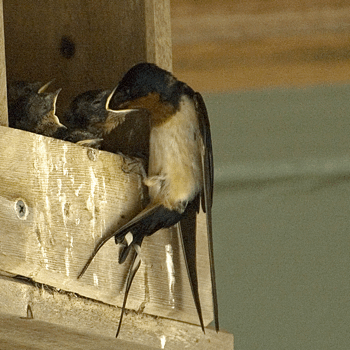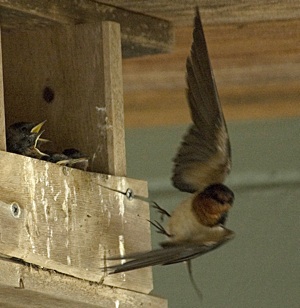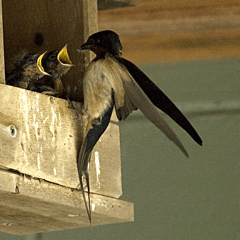Down the Hatch
Air Date: Week of August 7, 2009

((c) Salt Marsh Diary)
Mealtime for the swallow family is a dance that begins and ends at the nest. It's not a quiet affair. Salt Marsh Diary writer Mark Seth Lender has these observations.
Transcript
YOUNG: Barn Swallows are wonderfully acrobatic fliers. They have to be to capture enough insects to feed fast-growing nestlings. Mark Seth Lender watched a pair of the small birds take on the huge task.
LENDER: Beneath the sheltering overhang, barn swallows tend their young. Both parents share the work though it is more than work. It is obsession. From first light in widening circles they head out in search of food. The effort is continuous. They sweep and glide in giddy arcs made more magnificent by contrast to their tiny size, sharp blue wing and rounded umber chest flashing by. The skill, taking insects on the fly, is a combination of what can be taught…and what took ten million years to learn.

((c) Salt Marsh Diary)
Every sortie begins and ends at the nest. A dull construction made of spittle and mud it clings to the place where it was built as stuck as glue. Inside, the baby birds, barely feathered, wait noiselessly - until a parent appears. Then, cacophony. The chorus of their little voices is like the grating of sand on glass.
So, it’s one to the brood and, two down the hatch and, three off again and even then that gob is never full.

((c) Salt Marsh Diary)
When the parents leave the babes jockey for position. This particular pair of swallows have a tendency to feed their offspring from the same direction, right to left, moving along that always hungry line to each in turn. Which only encourages the strongest and most audacious to switch on subsequent feedings from first place, to second, then third and finally fourth for all the extras he or she can glom. The parents are fooled only some of the time but there is always one a little larger than the others. If politeness counts it is not here.
Meanwhile the ones not fed righteously bellow, each louder than their fellows. And it goes like this all day and it does not stop till dark for even in twilight, when a miniscule prey is that much more invisible, still the parents strive to feed those toothless sharks they bore, who’s only word is more!

((c) Salt Marsh Diary)
Swallows if they dream must dream of gaping mouths. Though they bear their burden in silence I think that they would comment if they could, they just don’t have the time. Such is nature’s trick: parents spend the coin of their lives that progeny will survive.
YOUNG: Mark Seth Lender writes a syndicated column called “Salt Marsh Diary.” To see some of his photographs, go to loe.org.
Living on Earth wants to hear from you!
Living on Earth
62 Calef Highway, Suite 212
Lee, NH 03861
Telephone: 617-287-4121
E-mail: comments@loe.org
Newsletter [Click here]
Donate to Living on Earth!
Living on Earth is an independent media program and relies entirely on contributions from listeners and institutions supporting public service. Please donate now to preserve an independent environmental voice.
NewsletterLiving on Earth offers a weekly delivery of the show's rundown to your mailbox. Sign up for our newsletter today!
 Sailors For The Sea: Be the change you want to sea.
Sailors For The Sea: Be the change you want to sea.
 The Grantham Foundation for the Protection of the Environment: Committed to protecting and improving the health of the global environment.
The Grantham Foundation for the Protection of the Environment: Committed to protecting and improving the health of the global environment.
 Contribute to Living on Earth and receive, as our gift to you, an archival print of one of Mark Seth Lender's extraordinary wildlife photographs. Follow the link to see Mark's current collection of photographs.
Contribute to Living on Earth and receive, as our gift to you, an archival print of one of Mark Seth Lender's extraordinary wildlife photographs. Follow the link to see Mark's current collection of photographs.
 Buy a signed copy of Mark Seth Lender's book Smeagull the Seagull & support Living on Earth
Buy a signed copy of Mark Seth Lender's book Smeagull the Seagull & support Living on Earth

